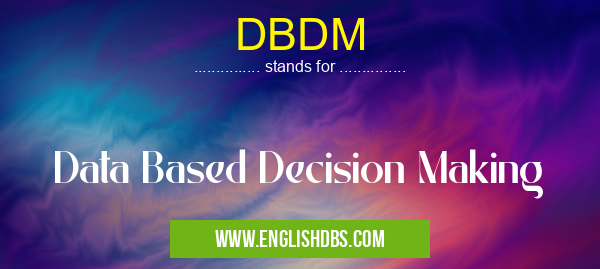What does DBDM mean in UNCLASSIFIED
DBDM stands for Data Based Decision Making. It is a process of using data to inform and support decision-making in organizations. DBDM involves collecting, analyzing, and interpreting data to gain insights and make better decisions.

DBDM meaning in Unclassified in Miscellaneous
DBDM mostly used in an acronym Unclassified in Category Miscellaneous that means Data Based Decision Making
Shorthand: DBDM,
Full Form: Data Based Decision Making
For more information of "Data Based Decision Making", see the section below.
What is DBDM?
DBDM is a data-driven approach to decision-making that emphasizes the use of objective, quantifiable information to inform decisions. It involves the following steps:
- Data collection: Gathering data from various sources, such as surveys, reports, and customer feedback.
- Data analysis: Using statistical methods and tools to analyze the data and identify patterns, trends, and relationships.
- Data interpretation: Drawing insights and conclusions from the analyzed data to inform decision-making.
- Decision implementation: Applying the insights gained from data analysis to make informed decisions and take appropriate actions.
Benefits of DBDM
Using DBDM offers numerous benefits, including:
- Improved decision quality: Data-driven decisions are based on objective evidence, leading to more informed and effective choices.
- Increased efficiency: DBDM streamlines decision-making processes by providing data-based insights and eliminating guesswork.
- Enhanced accountability: DBDM ensures that decisions are made transparently, with data supporting the reasoning behind each choice.
- Reduced risks: By using data to anticipate potential outcomes, DBDM helps organizations mitigate risks and make more informed choices.
Implementation of DBDM
Implementing DBDM in organizations involves:
- Data infrastructure: Establishing systems and processes for collecting, storing, and managing data.
- Data analytics capabilities: Developing the necessary skills and tools to analyze and interpret data.
- Culture of data-driven decision-making: Fostering a culture where data is valued and used to inform decisions at all levels.
Essential Questions and Answers on Data Based Decision Making in "MISCELLANEOUS»UNFILED"
What is Data Based Decision Making (DBDM)?
DBDM is the process of using data to make informed decisions in businesses or organizations. It involves collecting, analyzing, and interpreting data to identify patterns, trends, and insights that help decision-makers understand the situation and make better choices.
What are the benefits of DBDM?
DBDM offers several benefits, including:
- Improved decision-making: Data provides objective insights that reduce biases and improve the accuracy of decisions.
- Enhanced understanding: Data analysis reveals patterns and trends that help businesses understand their customers, market, and operations better.
- Increased efficiency: DBDM enables businesses to identify areas for improvement and streamline processes based on data-driven insights.
- Competitive advantage: Data-driven insights help businesses stay ahead of the competition by identifying opportunities and mitigating risks.
How can businesses implement DBDM?
Implementing DBDM typically involves the following steps:
- Data collection: Gather relevant data from internal and external sources.
- Data analysis: Use statistical techniques and data visualization tools to analyze the data and identify patterns.
- Interpretation: Draw insights from the data and identify potential actions based on the findings.
- Decision-making: Make informed decisions based on the data-driven insights.
- Evaluation: Monitor the outcomes of the decisions and make adjustments as needed.
What types of data are used in DBDM? A: DBDM can utilize various types of data, including: - Quantitative data: Numerical data that can be measured and analyzed statistically. - Qualitative data: Non-numerical data that provides insights into customer behavior, preferences, and opinions. - Internal data: Data generated within the business, such as sales records, financial data, and customer feedback. - External dat
DBDM can utilize various types of data, including:
- Quantitative data: Numerical data that can be measured and analyzed statistically.
- Qualitative data: Non-numerical data that provides insights into customer behavior, preferences, and opinions.
- Internal data: Data generated within the business, such as sales records, financial data, and customer feedback.
- External data: Data obtained from outside the business, such as market research, industry reports, and social media data.
What are some challenges associated with DBDM?
While DBDM offers significant benefits, it also presents some challenges:
- Data quality: Ensuring the accuracy and completeness of the data used is crucial for effective decision-making.
- Data overload: Businesses may face challenges in managing and analyzing large volumes of data.
- Lack of expertise: Organizations may require data scientists or analysts to interpret and utilize data effectively.
- Resistance to change: Implementing DBDM can involve organizational changes that may encounter resistance from employees.
Final Words: DBDM is a crucial approach for organizations seeking to make informed decisions based on objective data. By leveraging data analytics and insights, organizations can improve decision quality, enhance efficiency, increase accountability, reduce risks, and drive better outcomes. Embracing DBDM empowers organizations to operate more strategically and achieve their objectives effectively.
